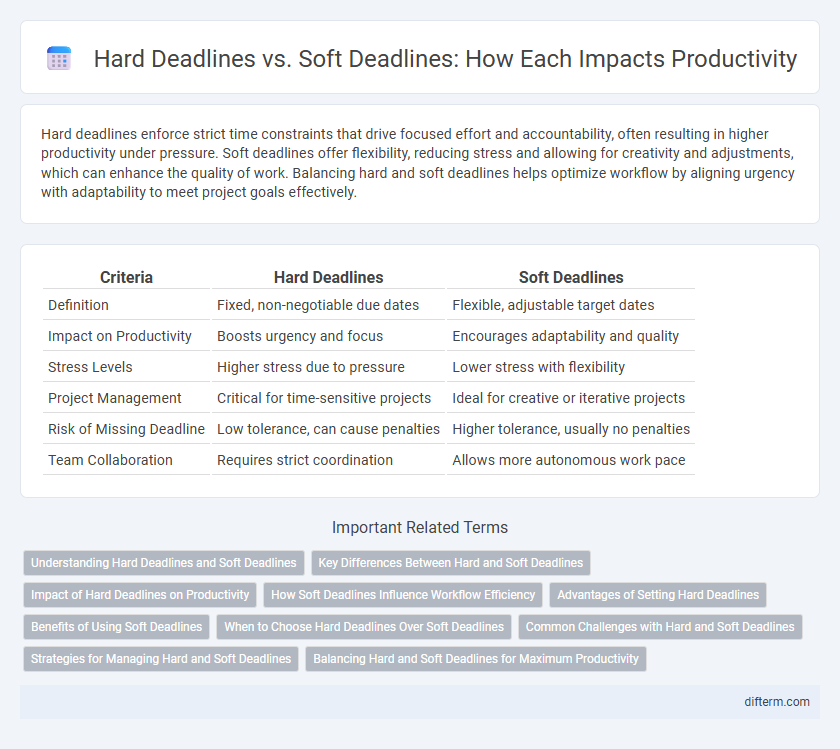Hard deadlines enforce strict time constraints that drive focused effort and accountability, often resulting in higher productivity under pressure. Soft deadlines offer flexibility, reducing stress and allowing for creativity and adjustments, which can enhance the quality of work. Balancing hard and soft deadlines helps optimize workflow by aligning urgency with adaptability to meet project goals effectively.
Table of Comparison
| Criteria | Hard Deadlines | Soft Deadlines |
|---|---|---|
| Definition | Fixed, non-negotiable due dates | Flexible, adjustable target dates |
| Impact on Productivity | Boosts urgency and focus | Encourages adaptability and quality |
| Stress Levels | Higher stress due to pressure | Lower stress with flexibility |
| Project Management | Critical for time-sensitive projects | Ideal for creative or iterative projects |
| Risk of Missing Deadline | Low tolerance, can cause penalties | Higher tolerance, usually no penalties |
| Team Collaboration | Requires strict coordination | Allows more autonomous work pace |
Understanding Hard Deadlines and Soft Deadlines
Hard deadlines are fixed, non-negotiable dates by which tasks must be completed, often critical for project success and legal compliance. Soft deadlines are flexible target dates that guide progress and allow adjustments without severe consequences. Recognizing the distinction ensures effective time management and prioritization in productivity strategies.
Key Differences Between Hard and Soft Deadlines
Hard deadlines require strict adherence to specific dates, often linked to legal, financial, or contractual obligations, ensuring accountability and preventing project delays. Soft deadlines offer flexible timeframes, promoting creativity and allowing adjustments based on progress and unforeseen challenges, enhancing team morale and innovation. Understanding the balance between these deadlines is crucial for effective project management and optimizing productivity outcomes.
Impact of Hard Deadlines on Productivity
Hard deadlines drive urgency and enhance focus, often leading to increased productivity by compelling individuals to prioritize tasks and minimize procrastination. The pressure of fixed completion dates minimizes time spent on less critical activities, fostering efficient time management and goal-oriented work. However, excessively rigid deadlines can induce stress, potentially impairing creativity and quality if not balanced with realistic timeframes.
How Soft Deadlines Influence Workflow Efficiency
Soft deadlines create a flexible workflow environment, allowing teams to adjust priorities and manage unexpected obstacles without compromising overall project progress. This adaptability reduces stress and encourages creative problem-solving, which enhances productivity and maintains steady momentum. By fostering a balanced pace, soft deadlines prevent burnout and support sustained efficiency throughout the project lifecycle.
Advantages of Setting Hard Deadlines
Setting hard deadlines enhances productivity by creating a strong sense of urgency, which helps prioritize tasks and reduce procrastination. Hard deadlines also improve time management and accountability, ensuring projects remain on track and are completed efficiently. This approach fosters clearer goal-setting and facilitates better resource allocation in both individual and team environments.
Benefits of Using Soft Deadlines
Soft deadlines enhance productivity by reducing stress and allowing greater flexibility in managing tasks, which improves overall work quality. They encourage proactive time management and foster creativity by providing space for iterative improvements. This adaptable approach to scheduling supports sustainable work habits and helps teams maintain momentum without burnout.
When to Choose Hard Deadlines Over Soft Deadlines
Hard deadlines are essential for projects with fixed delivery dates, such as product launches or regulatory compliance, where timely completion is non-negotiable for business success. Soft deadlines suit creative processes or exploratory tasks where flexibility enhances quality without risking critical outcomes. Choosing hard deadlines optimizes accountability and resource allocation, ensuring milestones are met when delays could result in significant financial or reputational damage.
Common Challenges with Hard and Soft Deadlines
Hard deadlines often create high-pressure environments that can lead to stress and reduced creativity, making it difficult for teams to adapt to unexpected changes. Soft deadlines, while flexible, may cause procrastination and lack of urgency, resulting in delayed project completion. Balancing these challenges requires clear communication and prioritization strategies to maintain productivity without compromising quality.
Strategies for Managing Hard and Soft Deadlines
Effective strategies for managing hard deadlines include prioritizing tasks, creating detailed schedules, and setting buffer times to accommodate unexpected delays. Soft deadlines benefit from flexible planning, regular progress reviews, and adaptive goal-setting to maintain momentum without causing stress. Utilizing digital tools for tracking both types of deadlines enhances organization and ensures timely project completion.
Balancing Hard and Soft Deadlines for Maximum Productivity
Balancing hard and soft deadlines enhances productivity by combining firm time constraints with flexible task management. Hard deadlines ensure accountability and prioritize critical deliverables, while soft deadlines foster creativity and reduce stress through adaptable scheduling. Integrating both types promotes efficient workflow, timely project completion, and sustained motivation.
Hard deadlines vs Soft deadlines Infographic

 difterm.com
difterm.com